Chapter 10, Biomembrane Structure: Lipid Bilayer, Membranelyco Proteins, Phospholipids, Sphinglolipids, Cholesterol
1/68
Earn XP
Description and Tags
Bolded vocab words from the slides defined by textbook glossary and prof
Name | Mastery | Learn | Test | Matching | Spaced |
|---|
No study sessions yet.
69 Terms
Compartmentalization
Membrane function, Membranes form continuous sheets that enclose intracellular compartments
Scaffold for Biochemical Activities
Membrane function, Membranes provide a framework that organizes enzymes for effective interactions
Selective Permeable Barrier
Membrane function, Membranes allow regulated exchange of substances between compartments
Transporting Solutes
Membrane function, Membrane proteins facilitate the movement of substances between compartments
Responding to External Signals
Membrane function, Membrane receptors transduce signals from outside the cell in response to specific ligands
Intracellular Interaction
Membrane function, Membranes mediate recognition and interaction between adjacent cells
Energy Transduction
Membrane function, Membranes transduce photosynthetic energy, covert chemical energy to ATP, and store energy
Plasma Membrane
The membrane surrounding a cell that separates the cell from its external environment; consists of a phospholipid bilayer and associated membrane lipids and proteins.
Membrane Transport Protein
Collective term for any integral membrane protein that mediates movement of one or more specific ions or small molecules across a cellular membrane regardless of the transport mechanism
Permeability
Allows liquids, gases, or small molecules/ ions to pass through it
Receptor Protein
A protein that binds a ligand, which could be a small molecule such as adrenalin, a growth factor such as epidermal growth factor, a hormone such as insulin, or another macromolecule, usually with engagement of a signaling cascade as a consequence.
Transmembrane proteins that bind extracellular signaling molecules and relay the information into the cell to generate a specific response.
Peripheral Membrane Protein
Any protein that associates with the cytosolic or exoplasmic face of a membrane but does not enter the hydrophobic core of the phospholipid bilayer.
Non-covalently associate with only one side of a biomembrane and coordinate diverse cellular activity
Cytoskeleton
Network of fibrous elements, consisting primarily of microtubules, microfilaments, and intermediate filaments, found in the cytoplasm of eukaryotic cells. The cytoskeleton provides organization and structural support for the cell and permits directed movement of organelles, chromosomes, and the cell itself.
Membrane associated proteins can bind to the cytoskeleton to establish, maintain, and change cell shape and organelle position.
Fluid Mosaic Model
Understanding of membrane function, integrity, and permeability is defined by the fluid mosaic model.
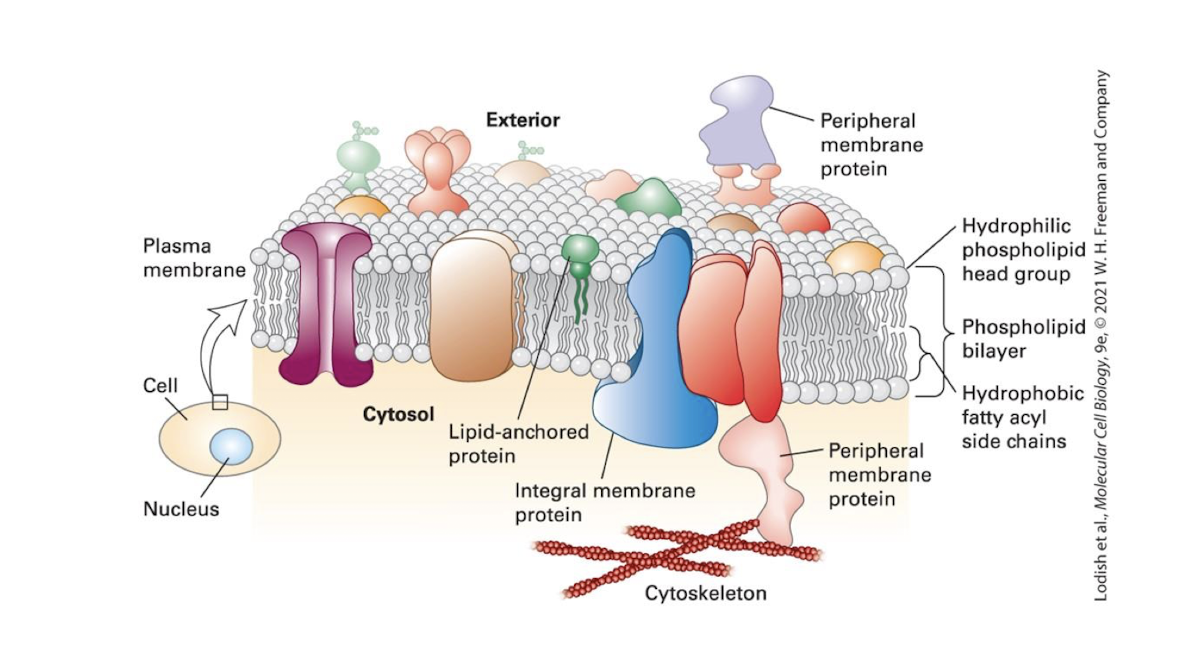
Leaflet
Each layer in the phospholipid bilayer. They behave like a 2D fluid.
Lipids can freely move laterally
They can spin on their axis
They are not locked in place by covalent bonds
They are held through combined electrostatic attraction and hydrophobic effect.
Mosaic
A biomembrane is composed of diverse lipids and proteins.
Fluidity of Fluid Mosaic Model
Allows cell shape to be dynamic- ex) during vesicle budding, fusion, and cell migration or division.
Mosaicism of Fluid Mosaic Model
Allows them to function as selective permeable membrane: The hydrophobic core of membrane prevents unassisted movement of water soluble substances across the bilayer.
Amphipathic (or amphiphilic)
Referring to a molecule or structure that has both a hydrophobic and a hydrophilic part.
Hydrocarbon
Any compound containing only carbon and hydrogen atoms.
Phospholipid Bilayer
A two-layer, sheet-like structure in which the polar head group of phospholipids are exposed to the aqueous media on either side and the non-polar fatty acyl chains are in the center; the foundation for all biomembranes.
Micelle
A water-soluble spherical aggregate of phospholipids or other amphipathic molecules that form spontaneously in aqueous solution.
Liposome
Artificial spherical phospholipid bilayer structure with an aqueous interior that forms in virto from phospholipids and may contain membrane proteins.
Lipid Nanoparticles (LNPs)
Novel drug delivery system, similar to liposomes but generally smaller, more stable, and with inverted small lipid spheres on the interior that hold small, charged molecules. Well suited for delivering nucleic acids.
Artificial Purely Phospholipid Bilayer Characteristics
Virtually impermeable to water soluble solutes
Inherently stable due to many electrostatic attractions and hydrophobic effect
Spontaneously form continuous, sealed compartments, without exposed hydrophobic region
Cytosolic Face
Leaflet/ face of a cell membrane directed towards the cytosol.
Exoplasmic Face
Leaflet/ face of a cell membrane directed away from the cytosol.
Luminal Leaflet
Inner leaflets of single membrane organelles face the inner space called the lumen.
Phosphoglycerides
Amphipathic derivatives of glycerol 3-phosphate that generally consist of two hydrophobic fatty acyl chains esterified to the hydroxyl groups in glycerol and a polar head group attached to the phosphate; the most abundant lipids in biomembranes.
Diacylglycerides with small functional alcohol head groups esterified to phosphate on the 3rd carbon.
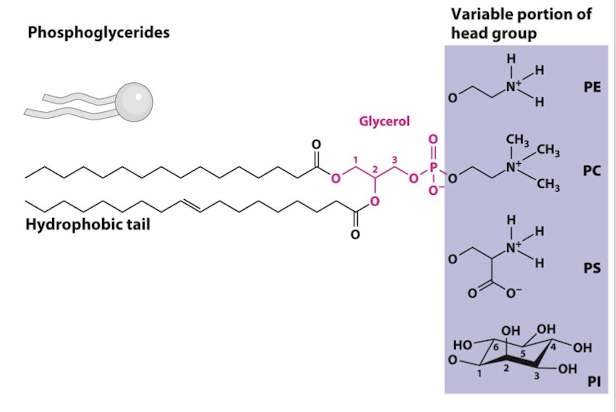
Sphingolipids
Major group of membrane lipids, derived from sphingosine, that contain two long hydrocarbon chains and either a phosphorylated head group (sphingomyelin) or carbohydrate head group (cerebrosides, gangliosides).
Ceramides formed by the attachment of sphingosine to fatty acids.
Sterols
Smaller and less amphipathic lipid that is only found in animals
Saturated
FA tails have only C-C single bonds (saturated in hydrogens).
Unsaturated
FA tails with at least one C=C double bond (Unsaturated in hydrogens).
Diacylglycerol
With just glycerol moiety and the two fatty acyl chains. Plays an important part in intracellular signaling.
Phosphatidic Acid
Phosphoglycerides without a head group, the simplest phosphoglyceride, but very rare in membranes.
Phosphoglyceride Head Group Traits
At neutral pH, PE (phosphatidylethanolamine) and PC (phosphatidylcholine) head groups have no charge- phosphate and nitrogen charges cancel, but they still have polarity.
PI (phosphatidylinositol) and PS (phosphatidylserine) both have net negative charge
Each is found in different rations in inner and outer leaflets and organelles
Each has unique roles in different cell activities
Plasmalogens
Are modified diacylglycderides. That ester bond on the C1 of the glycerol is enzymatically modified to a stronger ether linkage.
Same head group as the four major phosphoglycerides.
Found mostly in heart and brain cells (less likely to be attacked by oxygen).
Sphingomylelins (SM)
Most abundant: a phosphocholine head group. Their charge distribution and resistance to degradation make them great insulators in the myelin sheaths surrounding nerve cells.
Glycolipids
Any lipid to which a short carbohydrate chain is covalently linked; commonly found in the plasma membrane.
Covalently modified via carbohydrate additions to glycerol or sphingosine backbone.
Enriched in the plasma membrane outer leaflet.
Ganglioside
Glycolipids with highly branched sugar chains.
Cholesterol
A lipid containing the four-rind steroid structure with a hydroxyl group on one ring; a component of many eukaryotic membranes and the precursor of steroid hormones, bile acids, and vitamin D.
Buffers membrane fluidity.
bent shape prevents tight packing so it maintains fluid state at low temperatures
shape and weak polarity prevents cholesterol from diffusing easily so at high temps it prevents lipids from diffusing too rapidly
Phase Transition
In an artificial membrane if the temperature falls below 37˚C transitions from a fluid state to a gel-like, semisolid state- membrane dynamics are lost, and the membrane can fracture.
Temperature of phase transitions depend on:
Length of FA tails: longer tails promotes more van Der Waals interactions and the hydrophobic effect, therefore they decrease fluidity.
Saturation state: unsaturated tails have kinks that prevent regular packing, therefore unsaturated tails increase fluidity.
Scrarmblases
Enzymes that randomly flip new synthesized lipids from outer to inner leaflet to establish symmetry in lipid ratio between the two leaflets.
Flippases
Protein that facilitates the movement of membrane lipids from one leaflet to the other leaflet of a phospholipid bilayer.
Enzyme couple the energy of ATP hydrolysis to flip specific lipids from one leaflet to the other, establishing asymmetry in leaflet lipid composition.
Lipid Rafts
Micodomain in the plasma membrane that is enriched in cholesterol, sphingomyelin, and certain proteins.
Specialized micodomains of ordered lipid assembly within the disordered randomness of lipids elsewhere.
Integral Membrane Proteins
aka transmembrane proteins: span bilayer and have 3 domains
Cytoplasmic and exoplasmic domains are hydrophilic and resemble soluble proteins
Transmembrane domain: hydrophobic residues that span the membrane as alpha-helixes -or from a small number of eukaryote proteins as beta-sheets rolled into a barrel shape beta-barrel.
Lipid Anchored Proteins
Soluble proteins covalently linked to different classes of lipid.
Porins
Class of trimeric transmembrane proteins through which small water-soluble molecules can cross the membrane; present in outer mitochondrial and chloroplast membranes and in the outer membrane of gram-negative bacteria.
Beta-barrels hydrophilic residues line the interior and generate specificity, allowing only certain ions and small molecules to diffuse across.
Acylation
Cytosolic anchor.
N-terminal glycine of protein is covalently linked to a single saturated FA group embedded in cytosolic leaflet.
Critical in relaying signals.
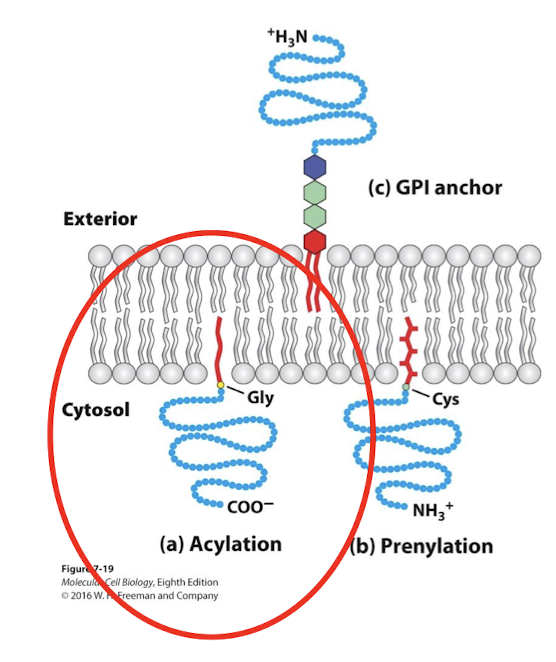
Prenylation
Cytosolic anchor.
Isoprene: a 5-carbon molecule used to construct many biological molecules.
C-terminal cysteine of protein is linked by thioester bond to one of these prenyl groups.
Important for intracellular signaling.

GPI (Glycosylphosphatidylinositol) anchored proteins
Exoplasmic anchor.
C-terminus of protein is covalenly linked to a short sugar polymer attached to the phospholipid phosphatidylinositol (PI)
Most are enzymatically cleaved and released as signaling proteins.
Others regulate certain receptor proteins’ ability to bing their signaling molecules.
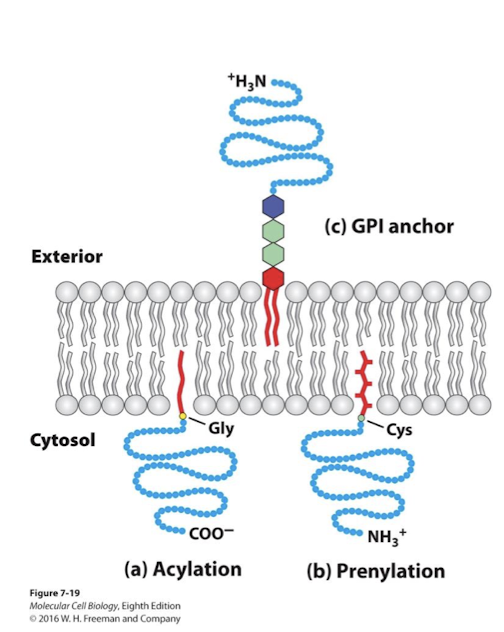
Glycoproteins
Covalently modified via carbohydrate additions to serine, threonine, or asparagine.
Enriched in the plasma membrane outer leaflet.
O antigen
All human express enzymes that add a 5-sugar polymer to lipids and proteins in the plasma membrane of red blood cells and many other cell types express-this constitutes the O antigen.
A gene called the ABO gene encodes a glycosyltransferase enzyme which adds an additional sugar molecule to the O antigen.
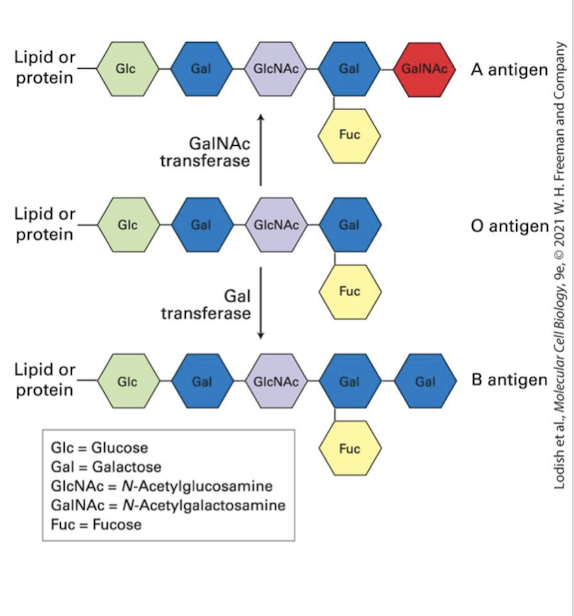
A Allele in ABO gene
The enzyme has specificity for the sugar N-acetylgalactosamine (GalNAc), generating the A antigen

B Allele in ABO gene
the enzyme has specificity for the sugar N-galactose, generating the B antigen
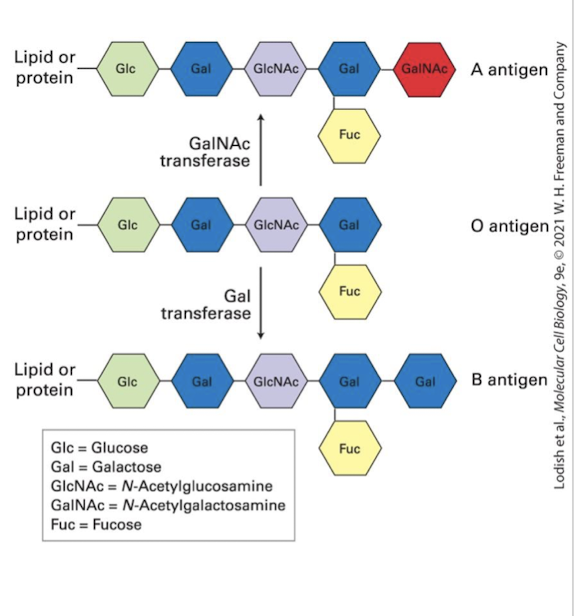
O allele in ABO gene
The enzyme is non-functional- no extra sugar added, the O antigen is unchanged.
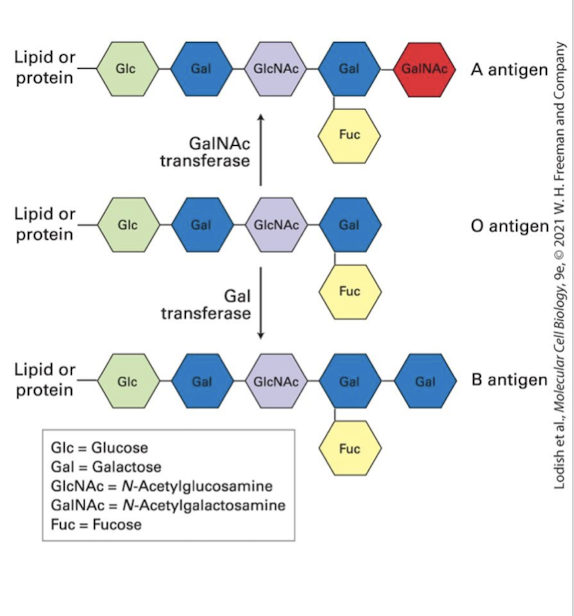
Blood Types
A: A/A A/O
B: B/B B/O
O: O/O
AB: A/B
AB universal acceptor
O universal donor
Coenzyme A (CoA)
A vitamin B5-derived coenzyme is used as an energy carrier in many enzymatic processes: lipid transport, phospholipid synthesis, and cellular cellular respiration, etc.
Uses transfer potential like ATP.
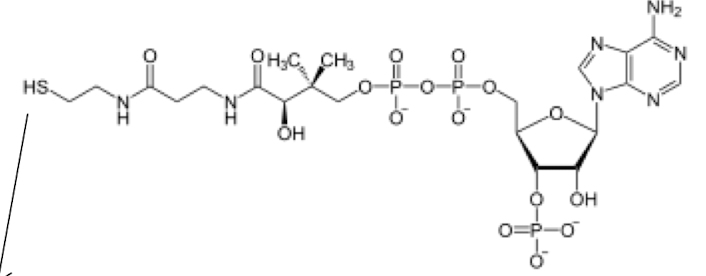
Acetyl CoA
Small, water-soluble metabolite comprising an acetyl group linked to coenzyme A (CoA). The acetyl group is transferred to citrate in the citric acid cycle and is used as a carbon source in the synthesis of fatty acids, steroid, and other molecules.
Add acetyl by thioester linkage to Coenzyme A. High energy bond for transfer potential.

Thioester linkages
unstable (high energy bonds like those in ATP) that when presented with an appropriate reacting partner by an enzyme will spontaneously break and transfer the attached group to the other molecule generating a more stable bond.
Fatty Acid Synthesis

Fatty Acyl-CoA (FA-CoA)
A hydrocarbon cahin attached to CoA by a thioester linkage.
Phospholipid synthesis
In the ER membrane

Transfer Potential
The spontaneous transfer of the fatty acid from CoA to glycerol phosphate occurs because the resulting bond is more stable than the thioester bond in the Fatty acyl-CoA.
Cholesterol BiosyntheticPathway
Step 2 production of Mevalonate is the rate limiting step.
The rate limiting step of cholesterol synthesis is catalyzed by the ER transmembrane protein HMG-CoA-Reductase which removes the CoA and releases a 5-carbon molecule called mevalonate into the ER.

Rate-limiting Step
In a metabolic pathway is the slowest and generally the step that requires the greatest activation energy or the transition state of highest free energy.
The step most effectively targeted by inhibitory pharmaceuticals designed to block or slow down a biological process.
Cholesterol Biosynthetic Pathway Example of regulating enzymatic activity
The HMG-CoA-Reductace catalytic domain extends into the cytoplasm from the ER cytosolic leaflet
5 transmembrane domains constitute a sterol sensing domain
If cholesterol levels are high in the ER membrane, they bind the sterol sensing domain. This alters the enzyme conformation and forces it to bind two other integral membrane proteins.
This interaction targets HMG-CoA-Reductase for polyubiquitination and proteasomal degradation.
As a result, cholesterol synthesis is shut off, temporarily.
Statins
Atherosclerosis (Clogging of the arteries) results from excessive accumulation of cholesterol and other lipids in the inner walls of arteries.
(Lipitor ex) most successful anti-atherosclerosis drugs which are competitive inhibitors that bind block activity of HMG-CoA-Reductase thereby limiting cholesterol synthesis.